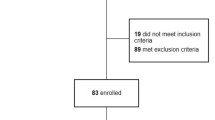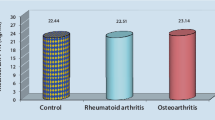Abstract
The aim of this study was to investigate sRANKL and OPG levels in serum and synovial fluid (SF) and to evaluate their relations in patients with RA in comparison to those with non-erosive arthritis (NEA). The study included 45 unselected RA patients with knee joint effusions and 27 patients with knee joint effusions because of NEA. Serum and SF samples were investigated isochronously. OPG and sRANKL were measured by ELISA assays. In RA, sRANKL levels were higher in serum than in SF (P = 0.007). In contrast, the NEA revealed higher sRANKL in SF compared to the serum (P = 0.001). Though in RA the average levels of sRANKLser were 5.6 times and of sRANKLsyn 1.5 times higher than in NEA, the differences were not significant. The free (unbound) OPG in SF was not significantly different in RA compared to NEA. Also in serum, the measured free OPG was only slightly higher in RA. There were no significant differences between RA and NEA concerning ESR and CRP. Significant correlations could be found between sRANKLsyn and CRP (r = 0.453; P = 0.005) as well as ESR (r = 0.362; P = 0.033) in RA. Nearly a positive correlation was evident also between sRANKLsyn and CRP in NEA (r = 0.520; P = 0.08). RA and NEA differ in particular concerning their power and intensity to destruct the juxtaarticular bone. This is the most remarkable finding of this study, that in RA a high part of sRANKL seems to be OPG bound and cleared by the blood stream, but the sRANKL neutralizing capacity of produced OPG in opposite to NEA is not sufficient to prevent osteoclast activation and bone destruction in the RA joint.


Similar content being viewed by others
References
Hofbauer LC, Heufelder AE (2001) Role of receptor activator of nuclear factor-κB ligand and osteoprotegerin in bone cell biology. J Mol Med 79:243–253
Kong Y-Y, Yoshida H, Sarosi I, Tan H-L, Timms E, Capparelli C, Morony S, Oliveira-dos-Santos AJ, Van G, Itie A, Khoo W, Wakeham A, Dunstan CR, Lacey DL, Mak TW, Boyle WJ, Penninger JM (1999) OPGL is a key regulator of osteoclastogenesis, lymphocyte development and lymph-node orgenogenesis. Nature 397:315–323
Wong BR, Rho J, Arron J, Robinson E, Orlinick J, Chao M, Kalachikov S, Cayani E, Bartlett FS III, Frankel WN, Lee SY, Choi Y (1997) TRANCE is a novel ligand of the tumor necrosis factor receptor family that activates c-Jun N-terminal kinase in T cells. J Biol Chem 272:25190–25194
Kong Y-Y, Feige U, Sarosi I, Bolon B, Tafuri A, Morony S, Capparelli C, Li J, Elliot R, McCabe S, Wong T, Campagnuolo G, Moran E, Bogoch ER, Van G, Nguyen LT, Ohashi PS, Lacey DL, Fish E, Boyle WJ, Penninger JM (1999) Activated T cells regulate bone loss and joint destruction in adjuvant arthritis through osteoprotegerin ligand. Nature 402:304–309
Lum L, Wong BR, Josien R, Becherer JD, Erdjument-Bromage H, Schlöndorff J, Tempst P, Choi Y, Blobel CP (1999) Evidence for a role of a tumor necrosis factor-α (TNF-α)-converting enzyme-like protease in shedding of TRANCE, a TNF family member involved in osteoclastogenesis and dendritic cell survival. J Biol Chem 274(19):13613–13618
Fata JE, Kong YY, Li J, Sasaki T, Irie-Sasaki J, Moorehead RA, Elliott R, Scully S, Voura EB, Lacey DL, Boyle WJ, Khokha R, Penninger JM (2000) The osteoclast differentiation factor osteoprotegerin-ligand is essential for mammary gland development. Cell 103:41–50
Hsu H, Lacey DL, Dunstan CR, Solovyev I, Colombero A, Timms E, Tan H-L, Elliott G, Kelley MJ, Sarosi I, Wang L, Xia X-Z, Elliott R, Chiu L, Black T, Scully S, Capparelli C, Morony S, Shimamoto G, Bass MB, Boyle WJ (1999) Tumor necrosis factor receptor family member RANK mediates osteoclast differentiation and activation induced by osteoprotegerin ligand. Proc Natl Acad Sci USA 96:3540–3545
Simonet WS, Lacey DL, Dunstan CR, Kelley M, Chang M-S, Lüthy R, Nguyen HQ, Wooden S, Bennett L, Boone T, Shimamoto G, DeRose M, Elliot R, Colombero A, Tan H-L, Trail G, Sullivan J, Davy E, Bucay N, Renshaw-Gegg L, Hughes TM, Hill D, Pattison W, Campbell P, Sander S, Van G, Tarpley J, Derby P, Lee R, Amgen EST Program, Boyle WJ 1997 Osteoprotegerin: a novel secreted protein involved in the regulation of bone densitiy. Cell 89:309–319
Itonaga I, Fujikawa Y, Sabokar A, Murray DW, Athanasou NA (2000) Rheumatoid arthritis synovial macrophage–osteoclast differentiation is osteoprotegerin ligand-dependent. J Pathol 192:97–104
Burgess TL, Qian Y-X, Kaufman S, Ring BD, Van G, Capparelli C, Kelley M, Hsu H, Boyle WJ, Dunstan CR, Hu S, Lacey DL (1999) The ligand for osteoprotegerin (OPGL) directly activates mature osteoclasts. J Cell Biol 145(3):527–538
Crotti TN, Smith MD, Weedon H, Ahern MJ, Findlay DM, Kraan M, Tak PP, Haynes DR (2002) Receptor activator NF-κB ligand (RANKL) expression in synovial tissue from patients with rheumatoid arthritis, spondyloarthropathy, osteoarthritis, and from normal patients: semiquantitative and quantitative analysis. Ann Rheum Dis 61:1047–1054
Pettit AR, Walsh NC, Manning C, Goldring SR, Gravallese EM (2006) RANKL protein is expressed at the pannus–bone interface at sites of articular bone erosion in rheumatoid arthritis. Rheumatology (Oxford) 45(9):1068–1076
Haynes DR, Barg E, Crotti TN, Holding C, Weedon H, Atkins GJ, Zannetino A, Ahern MJ, Coleman M, Roberts-Thomson PJ, Kraan M, Tak PP, Smith MD (2003) Osteoprotegerin expression in synovial tissue from patients with rheumatoid arthritis, spondyloarthropathies and osteoarthritis and normal controls. Rheumatology 42:123–134
Kotake S, Udagawa N, Hakoda M, Mogi M, Yano K, Tsuda E, Takahashi K, Furuya T, Ishiyama S, Kim K-J, Saito S, Nishikawa T, Takahashi N, Togari A, Tomatsu T, Suda T, Kamatani N (2001) Activated human T cells directly induce osteoclastogenesis from human monocytes. Arthritis Rheum 44(5):1003–1012
Hofbauer LC, Schoppet M (2004) Clinical implications of the osteoprotegerin/RANKL/RANK system for bone and vascular diseases. J Am Med Assoc 292(4):490–495
Ziolkowska M, Kurowska M, Radzikowska A, Luszczykiewicz G, Wiland P, Dziewczopolski W, Filipowicz-Sosnowska A, Pazdur J, Szechinski J, Kowalczewski J, Rell-Bakalarska M, Maslinski W (2002) High levels of osteoprotegerin and soluble receptor activator of nuclear factor κB ligand in serum of rheumatoid arthritis patients and their normalization after anti-tumor necrosis factor α treatment. Arthritis Rheum 46(7):1744–1753
Skoumal M, Kolarz G, Haberhauer, Woloszczuk W, Hawa G, Klingler A (2005) Osteoprotegerin and the receptor activator of NF-kappa B ligand in the serum and synovial fluid. A comparison of patients with longstanding rheumatoid arthritis and osteoarthritis. Rheumatol Int 26(1):63–69
Gravallese EM, Manning C, Tsay A, Naito A, Pan C, Amento E, Goldring SR (2000) Synovial tissue in rheumatoid arthritis is a source of osteoclast differentiation factor. Arthritis Rheum 43(2):259–269
Miranda-Carus ME, Benito-Miguel M, Balsa A, Cobo-Ibanez T, Perez de Ayala C, Pascual-Salcedo D, Martin-Mola E (2006) Peripheral blood T lymphocytes from patients with early rheumatoid arthritis express RANKL and interleukin-15 on the cell suface and promote osteoclastogenesis in autologous monocytes. Arthritis Rheum 54(4):1151–1164
Kolarz G, Schödl C, Skoumal M, Woloszczuk W, Wottawa A (2003) Ostoeprotegerin serum levels in rheumatoid arthritis. J für Mineralstoffwechsel 10(3):10–12
Author information
Authors and Affiliations
Corresponding author
Rights and permissions
About this article
Cite this article
Hein, G.E., Meister, M., Oelzner, P. et al. sRANKL and OPG in serum and synovial fluid of patients with rheumatoid arthritis in comparison to non-destructive chronic arthritis. Rheumatol Int 28, 765–769 (2008). https://doi.org/10.1007/s00296-007-0514-3
Received:
Accepted:
Published:
Issue Date:
DOI: https://doi.org/10.1007/s00296-007-0514-3




